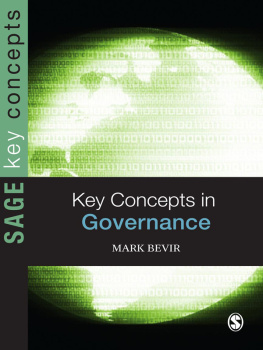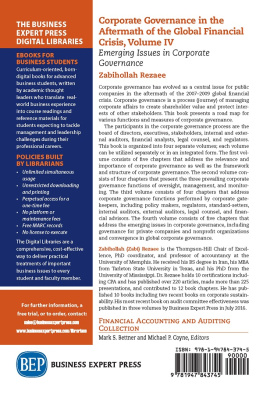CORPORATE GOVERNANCE
CORPORATE GOVERNANCE
History, Evolution and India Story
PRAVEEN B MALLA PHD
First published 2010
By Routledge
912915 Tolstoy House, 1517 Tolstoy Marg, New Delhi 110 001
Simultaneously published in UK
by Routledge
2 Park Square, Milton Park, Abingdon, Oxon, OX14 4RN
Routledge is an imprint of the Taylor & Francis Group, an informa business
Transferred to Digital Printing 2010
2010 Praveen B Malla
Typeset by
Bukprint India
B-180A Guru Nanak Pura, Laxmi Nagar,
Delhi 110 092
All rights reserved. No part of this book may be reproduced or utilised in any form or by any electronic, mechanical or other means, now known or hereafter invented, including photocopying and recording, or in any information storage and retrieval system without permission in writing from the publishers.
British Library Cataloging-in-Publication Data
A catalogue record of this book is available from the British Library
ISBN: 978-0-415-58990-1
Dedicated to the memory of my
Late father
M.R. Rao
Contents
As a corporate governance researcher, I have always been on the lookout for a book that explains the concept in a very simple yet forceful way. For me, complicating simple ideas is a science and simplifying complex ideas, an art. And I prefer the latter.
This book is aimed at the novice student of corporate governance who wants to understand the basics of the concept. There are no pretensions about this book. Wherever needed, the language is allowed to lisp and at times I indulge in providing a flight to the readers' thoughts. I have written the book the way I would want to read it. I hope that the novice reader will not be let down. Some ideas are reiterated across chapters, deliberately. My agenda is very simple: the novice reader should have a fairly strong understanding of the concept by the time she completes reading the book.
Ever since the corporate form with limited liability emerged, the problems of corporate governance made their way into corporations. It is difficult to say precisely when this term was first coined. But both the academics and researchers concur that not before the year 1932 was corporate governance viewed seriously.
The recent proliferation in corporate governance literature has focused on ways that corporations work. The firm behavior was earlier modeled on the black-box argument of the neo-classicists who asserted that firms are nothing more than production counters. All activities of the firm were so geared as to maximize profits. Finance literature has come a long way in explaining the various theories of firms and the behaviors associated with them. However, with the increasing awareness that mere economic and production-based explanations do not adequately describe the motivations for governance, researchers have focused on the behavioral side of the firm performance to justify the economic rationale of their typical behaviors.
Ronald Coase's seminal work in 1937 on the nature of the firms, where he emphasizes the importance of authority and direction that characterize the boundaries of the firm, has revolutionized the way researchers perceive firm behavior. His work gained further impetus with Alchian and Demsetz viewing the firm as a web of contractual relations. Monitoring team production could only be possible if the firm was characterized by contractual obligations. Subsequent development of agent-theoretic models, following Jensen and Meckling's seminal article Theory of the firm: managerial behavior, agency costs and ownership structure, has focused on the behavioral motivations of individuals who run corporations.
However, the foundational argument of corporate governance as seen by the academic as well as other independent researchers can be traced back to the pioneering work of Berle and Means who observed, as early as in the 1930s, that the modern corporations having grown gigantically can separate the control over a firm from ownership. Erstwhile promoters who largely controlled and managed organizations, increasingly needed specialized skills. Professionals with the required skills were to be hired. Berle and Means' observation on the departure of the owners from the actual control of the corporations led to a renewed emphasis on the behavioral dimension of the theory of the firm.
The modern-day uproar over corporate governance problemsof insider trading, excessive executive compensation, managerial expropriation of shareholders' wealth, false reporting, accounting non-disclosures and self dealing, among othersare assumed to be related to the theory of separation of ownership and control.
Throughout the book, the connect to conflicts of interest arising out of separation of ownership and control is constantly made through the different sections and chapters.
The importance and emergence of corporate governance in India is deeply influenced by the nature of relation that has existed between the corporate world on the one hand and the Indian state policies on the other. There are twin pressures exerting themselves on this relation. Between the post-Independence (post-1947) and pre-liberalization period, the relation between the industry and the State was particularly susceptible to lack of accountability in terms of certain corporate governance norms. This period can be largely understood in terms of a relationship-based governance model prominently adopted in Japan and Germany. The structure of the relationship between the industry and the State did exist but it was rather flawed from the perspective of corporate governance norms.
In the post-liberalization period (post-1991), the onset of market openness brought its own set of challenges and opportunities. Though the State-industry relation has not completely abated, it appears that market-oriented governance models are able to provide important insights into the functioning of corporations. An understanding of corporate governance functioning in India thus requires incorporating insights from both the relationship-based and market-oriented models.
India is at the crossroads in terms of charting a new path of adopting a corporate governance model. It needs to take due cognizance of insights from both schools of thought and perhaps create a new balanced model for other emerging economies. Some readers may disagree with the thought that Indian corporate governance model is still at the crossroads. The recent Satyam scam has exposed the holes in the market-oriented model and historically, corporate misgovernance in India can be attributed to the existence of shades of relationship-based governance model. So none of the two predominant models can explain away the Indian context easily.
The last section closely examines and analyzes the events that have stymied the evolution of corporate governance in India, in contrast to most other studies that have dealt with the evolution of corporate governance as a post-liberalization, post-globalization phenomenon. The relationship that existed between the industry and the State has been looked at in detail to explain my contention that corporate misgovernance has plagued Indian corporate sector right from the time of India's Independence. I argue from two different perspectivessystemic and relationship-basedto explain the reasons that created the space for corporate mis-governance. At the end, the arguments converge at a single underlying explanation: the nexus between the industry and the State has been largely responsible for the failure of the corporate governance system in the country. Readers may realize that some of the facts and figures in the India story are dated, but suffice it to say that such dated facts and figures have been deliberately used to expose the industry-State nexus. Though the latest facts and figures do not take away from the arguments, still they do not explain the nexus as strongly as the dated ones do. Since the section was designed to enlighten the reader with the evolution of the concept of corporate governance, I have taken the researcher's liberty in the use of such facts and figures.










